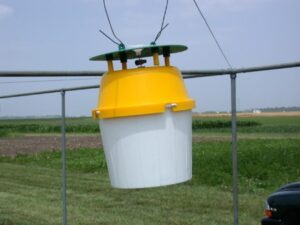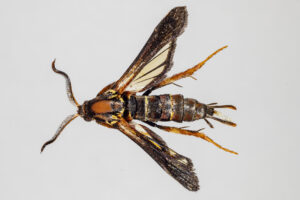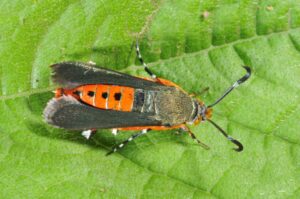This is my second year coordinating a bucket trap network to monitor squash vine borers. And, for a second year in a row we are witnessing some interesting organisms in the trap. The first of which is the unfortunate capture of pollinators. This is nearly unavoidable because of the color attraction; yellow mimics flowers, but also stressed or susceptible plants and tends to be a universal color cue that many insects use to locate suitable hosts. Therefore, the yellow lid on the bucket itself inadvertently attracts some beneficial insects.
The second is a different species of clear wing moth. Despite the fact that we place a pheromone lure in the top of the trap lid that mimics that produced specifically by females of the species Melittia cucurbitae (SVB; Figure 2), we have seen consistent attraction to and capture of another moth belonging to the clear-wing family (Sesiidae), known as the grape root borer (GRB; Vitacea polistiformis; Figure 3). This pest species can be damaging in grape production but does not pose a threat to cucurbits.
The bottom line is that nothing beats actual scouting in the field. To minimize the damage caused by SVB in cucurbits be sure to scout your crop and look for the adults themselves, they are daytime fliers, and you may be lucky enough to see them in the crop. Effective management relies on the application of insecticides on the base of the plant at/near egg hatch, prior to the larvae boring into the stem of the plant where they remain protected from subsequent foliar applications.
Trap catches can be found here: https://extension.entm.purdue.edu/veg/squash-vine-borer/


